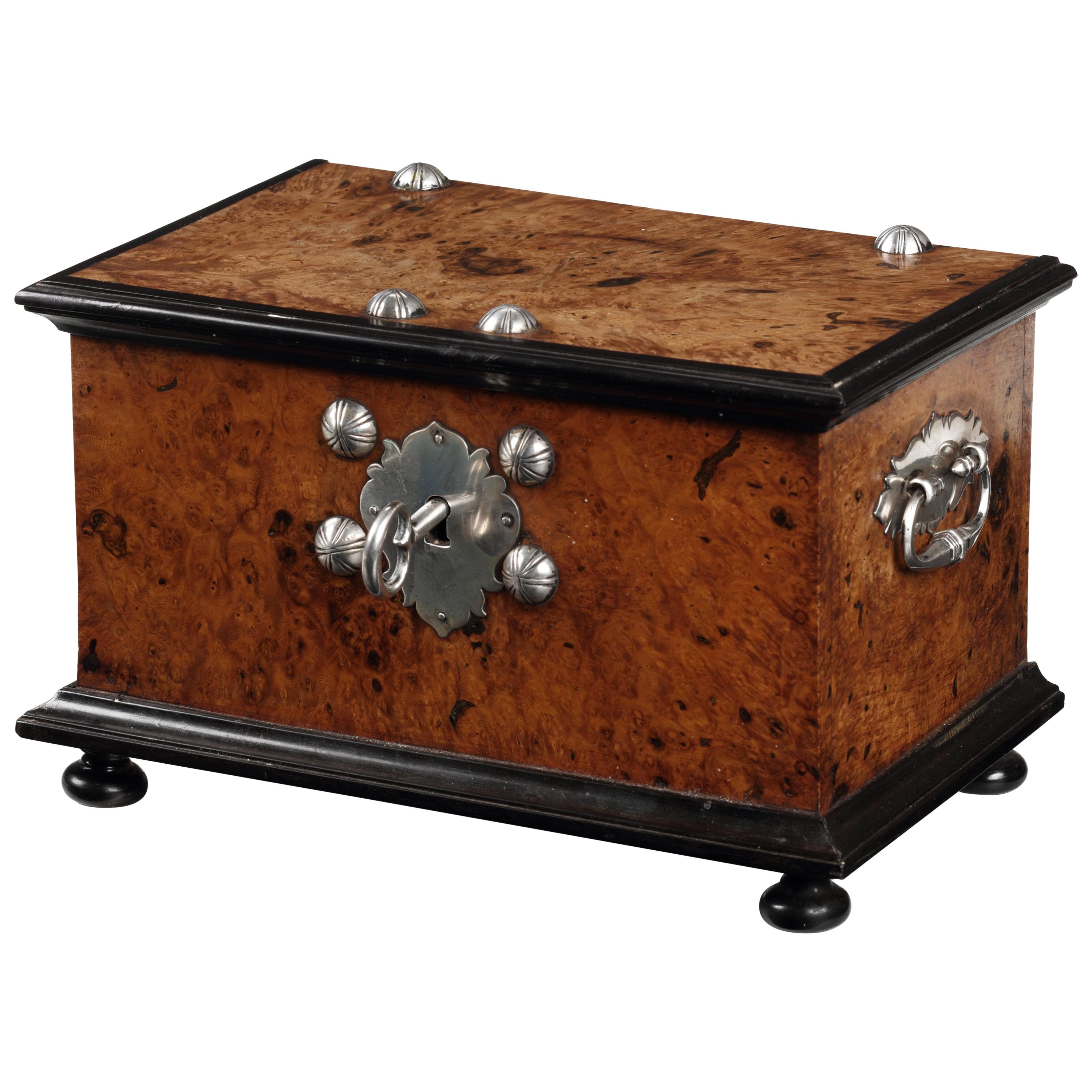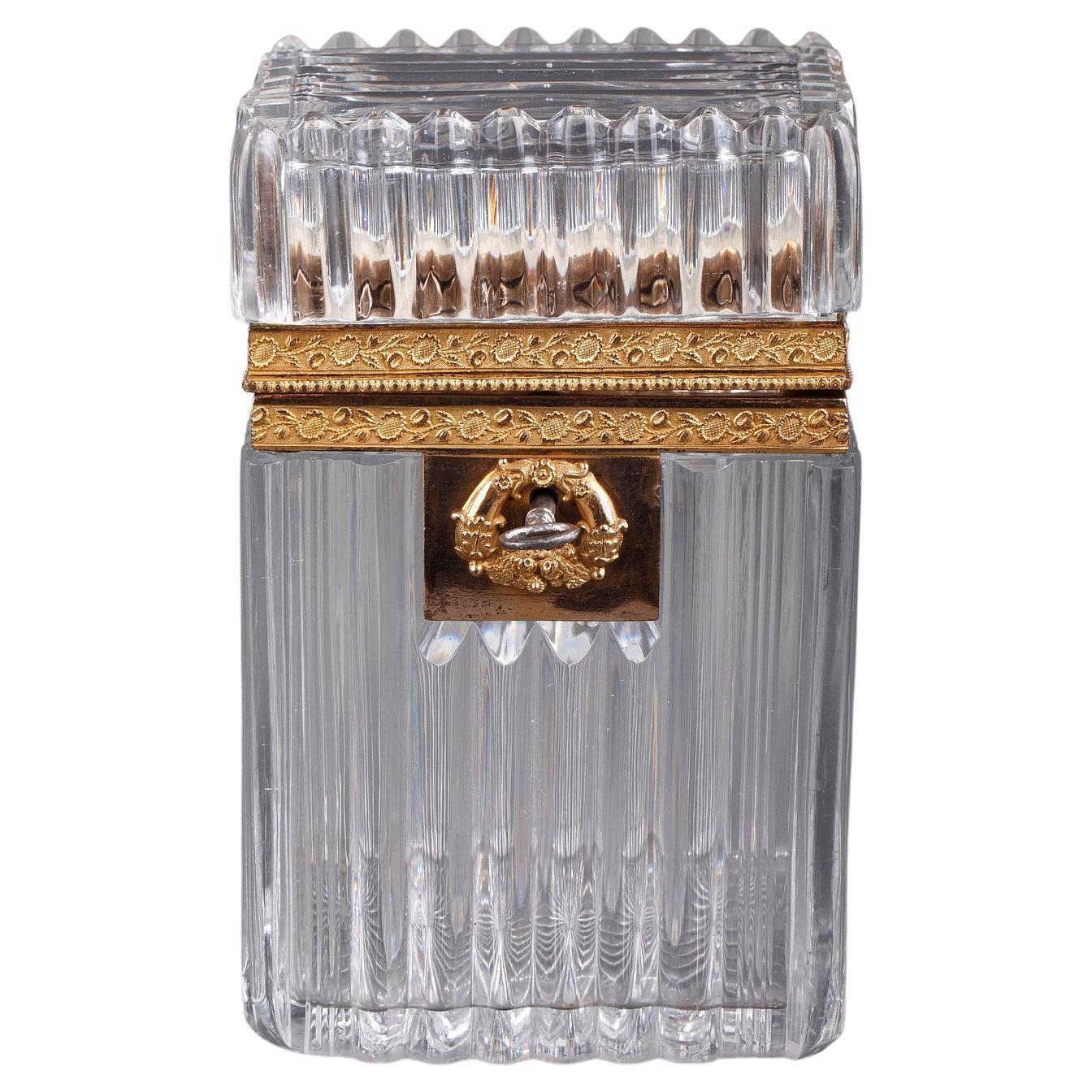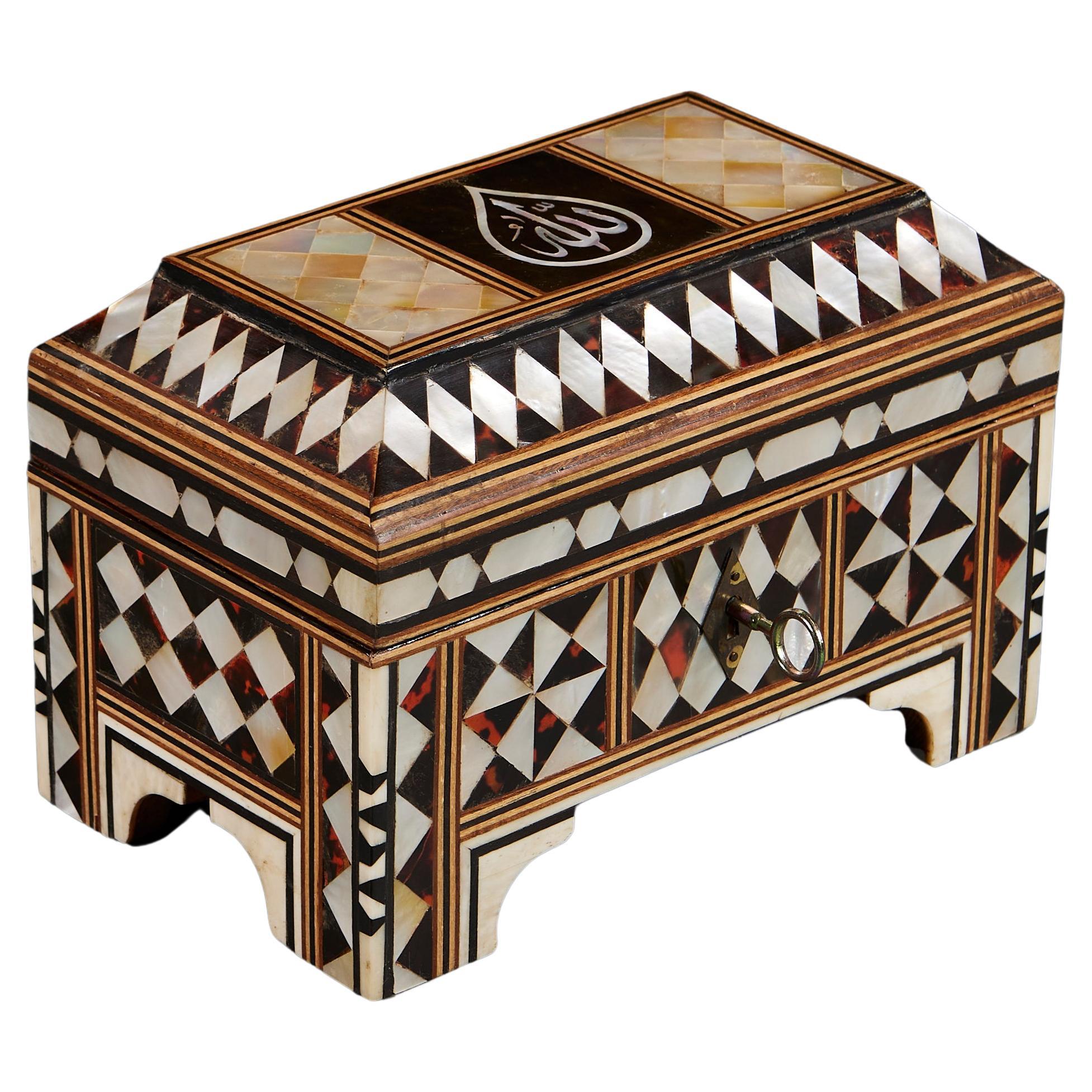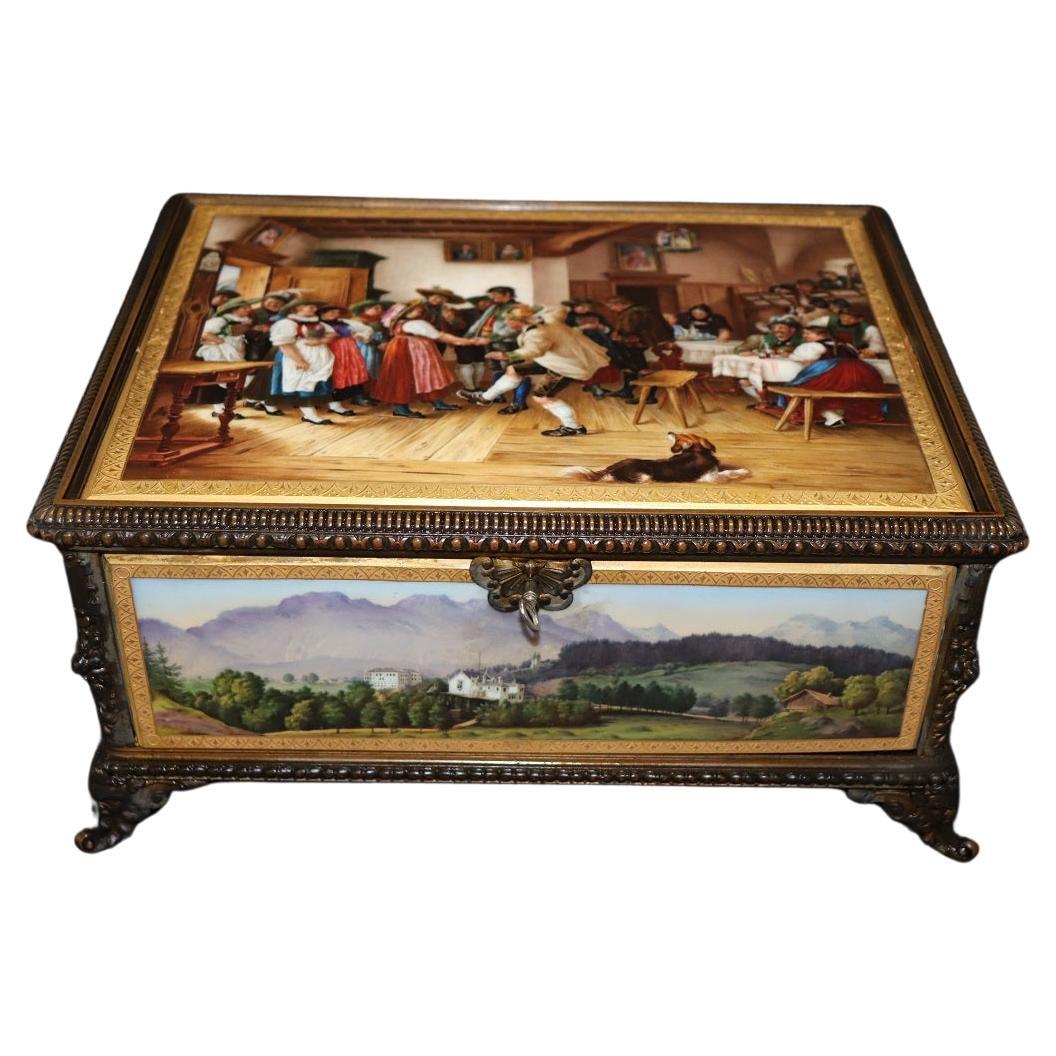Items Similar to A rare Indonesian tortoiseshell sirih casket with gold mounts
Want more images or videos?
Request additional images or videos from the seller
1 of 7
A rare Indonesian tortoiseshell sirih casket with gold mounts
About the Item
Batavia (Jakarta), 19th century, apparently unmarked
H. 5 x W. 18 x D. 13 cm
Before settling down to business in the former Dutch East Indies, sirih had to be offered in the most exquisite boxes of gold, silver, inlaid with precious stones, ivory, or tortoiseshell. The costliness of one’s sirih box displayed one’s fortunes. Sirih or Betel boxes with gold mounts are rare because the gold was often melted down in times of dire need. This particular box belonged to an Indonesian owner because it has a fob lock. Steeling in Indonesian culture means the one who got caught would have to live with one hand or not continue living at all. So, a lock was not needed. However, having a European ‘lock’ in your betel box was rather fashionable.
- Dimensions:Height: 1.97 in (5 cm)Width: 7.09 in (18 cm)Depth: 5.12 in (13 cm)
- Materials and Techniques:
- Place of Origin:
- Period:
- Date of Manufacture:19th century
- Condition:Wear consistent with age and use.
- Seller Location:Amsterdam, NL
- Reference Number:1stDibs: LU5458237860152
About the Seller
5.0
Vetted Seller
These experienced sellers undergo a comprehensive evaluation by our team of in-house experts.
Established in 1985
1stDibs seller since 2020
19 sales on 1stDibs
Typical response time: 3 hours
- ShippingRetrieving quote...Ships From: Amsterdam, Netherlands
- Return PolicyThis item cannot be returned.
More From This SellerView All
- Fine Dutch Colonial Indonesian Casket with Silver Mounts, circa 1706Located in Amsterdam, NLA fine Indonesian Ambonya burl, ebony and teak casket with silver mounts Jakarta (Batavia), circa 1706 (year letter W (1705-1710), marked DV, probably Dirck Vooght The outer ri...Category
Antique Early 18th Century Indonesian Dutch Colonial Decorative Boxes
MaterialsSterling Silver
- 18th-century Dutch-colonial Peranakan mother-of-pearl casket with silver mountsLocated in Amsterdam, NLAn Indonesian Peranakan mother-of-pearl inlaid mastic sirih casket with silver mounts Jakarta (Batavia), circa 1720-1730, the silver hinges marked for Batavia, maker’s mark HS or SH...Category
Antique Mid-18th Century Indonesian Dutch Colonial Antiquities
MaterialsSilver
- A small Dutch colonial Indonesian tortoiseshell betel box with gold mountsLocated in Amsterdam, NLJakarta (Batavia), 18th century, apparently unmarked L. 14 x W. 9.5 x H. 4.7 cm Before settling down to business in the former Dutch East Indies, sirih had to be offered in the mos...Category
Antique Late 18th Century Indonesian Dutch Colonial Antiquities
MaterialsGold
- Fine Indian Silver Filigree Casket with Hinged Cover, 18th CenturyLocated in Amsterdam, NLA pair of very fine silver filigree rosewater sprinklers Possibly India, Karimnagar, early 18th century Measures: Height 31.6 cm and 31.7 cm,...Category
Antique 18th Century Indian Metalwork
MaterialsSilver
- Fine Japanese Namban Lacquer Jewelry Casket, 17th CenturyLocated in Amsterdam, NLJapanese Namban lacquer transition-style coffer with two drawers Kyoto/Nagasaki, circa 1650 The cartouches with gilt and red decorations of leaves...Category
Antique 17th Century Japanese Edo Lacquer
MaterialsCypress
- 16th-Century Indo-Portuguese Colonial Mother-of-pearl Gujarat CasketLocated in Amsterdam, NLAn exceptional Indo-Portuguese colonial mother-of-pearl veneered casket with silver mounts India, Gujarat, 2nd half of the 16th century, the silver mounts Goa or probably Lisbon Measures: H. 16 x W. 24.6 x D. 16.1 cm An exceptional Gujarati casket with a rectangular box and truncated pyramidal lid (with slopes on each side and a flat top) made from exotic wood, probably teak (Tectona grandis), covered with a mother-of-pearl mosaic. The tesserae, cut from the shell of the green turban sea snail (Turbo marmoratus, a marine gastropod) in the shape of fish scales, are pinned to the wooden structure with silver ball-headed nails. The casket is set on bracket feet on the corners. The masterfully engraved decoration of the silver mounts follows the most refined and erudite Mannerist repertoire of rinceaux and ferroneries dating from the mid-16th century. The high quality and refinement of the silver mounts and, likewise, the silver nails that replaced the original brass pins used to hold the mother-of-pearl tesserae in place indicate the work of a silversmith probably working in Lisbon in the second half of the 16th century. The Indian origin of this production, namely from Cambay (Khambhat) and Surat in the present state of Gujarat in north India, is, as for the last three decades, consensual and fully demonstrated, not only by documentary and literary evidence - such as descriptions, travelogues and contemporary archival documentation - but also by the survival in situ of 16th-century wooden structures covered in mother-of-pearl tesserae. A fine example is a canopy decorating the tomb (dargah) of the Sufi saint, Sheik Salim Chisti (1478-1572) in Fatehpur Sikri in Agra district in the state of Uttar Pradesh, north India. This is an artistic production, geometric in character and Islamic in nature, where usually the mother-of-pearl tesserae form complex designs of fish scales or, similar to the dishes also made using the same technique, with the thin brass sheets and pins, stylized lotus flowers. The truncated pyramidal shape corresponds, like their contemporary tortoiseshell counterparts also made in Gujarat, to a piece of furniture used in the Indian subcontinent within the Islamic world prior to the arrival of the first Portuguese. This shape, in fact, is very old and peculiar to East-Asian caskets, chests or boxes used to contain and protect Buddhist texts, the sutras. A similar chest is the famous and large reliquary chest from Lisbon cathedral that once contained the relics of the city's patron saint, Saint Vincent. Both match in shape, having the same kind of socle or pedestal and bracket feet, and in their engraved silver mountings, featuring the same type of refined, erudite decoration. Their differences lie in the silver borders that frame the entire length of the edges of the chest (both the box and the lid), pinned with silver nails, and on the lock plate, shaped like a coat of arms in the Lisbon example. Given the exceptional dimensions of the reliquary casket...Category
Antique 16th Century Indian Jewelry Boxes
MaterialsSilver
You May Also Like
- Charles X Cut Crystal Casket with Ormulu MountsLocated in Paris, FRA rectangular cut-crystal casket with a "bamboo" cut. The crystal is set in an ormolu mount with finely chased flower bands. The lock is decorated with a motif of cornucopia. This bo...Category
Antique 1820s French Decorative Boxes
MaterialsCrystal
- An Ottoman mother of pearl and tortoiseshell casketLocated in London, GBTurkey, circa 1900 An early twentieth century Ottoman casket of small scale, decorated throughout with inlaid mother of pearl and tortoiseshell, the lid opening to reveal a red line...Category
Early 20th Century Turkish Decorative Boxes
MaterialsVelvet
- Antique Charles X French Cut Glass Casket with a Bronze MountBy BaccaratLocated in Philadelphia, PAA fine antique French cut glass casket. With a pressed and cut glass body and cover with a gilt bronze mount. Together with an associated key fo...Category
Antique Early 19th Century French Charles X Glass
MaterialsCut Glass
- Rare 19th Century Antique Bronze Mounted KPM Hand Painted Porcelain CasketBy KPM PorcelainLocated in Casale Monferrato, ITTruly rare, this finely decorated antique rectangular casket, German porcelain manufacturer KPM, circa 1870. The KPM brand is engraved on the inside. Made with a finely chiseled bron...Category
Antique 1870s German Decorative Boxes
MaterialsBronze
- Antique Large Crystal Box or Casket with Footed Bronze MountingLocated in Toronto, ONThis antique large crystal and bronze box makes a statement in any space. A very contemporary design for the early 1900s production, this piece transitions from modern to Classic int...Category
Early 20th Century French Decorative Boxes
MaterialsCrystal, Bronze
- A Rare and Important Sarcophagus ‘Wedding’ CasketLocated in London, GBA Rare and Important Sarcophagus ‘Wedding’ Casket Attributed to the Embriachi workshop / and the so-called: Master of the ‘Susanna Two’ Bone, Wood, P...Category
Antique 15th Century and Earlier Italian Decorative Boxes
MaterialsMetal
Recently Viewed
View AllMore Ways To Browse
Brass Floor Vase With Lid
Hair Comb With Case
Sevres Trinket Box
Serpentine Sofa Pair
Antique Monochrome Porcelain
Biedermeier Birch Armchairs
Iittala Ultima
Italian Parchment Ceiling Mount
Paper Globe Pendant
Vintage Chrome Bar Stools 1970s
Fontana Arte Hanger
George I Giltwood Mirror
Georgian Style Irish Mirror
Designline Brass
Drum Shaped Coffee Table
Gilt Epergne Centerpieces
Makeup Table White
Mid Century Parquet Coffee Table





